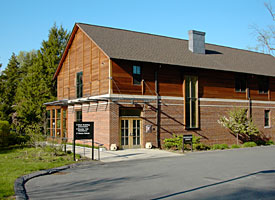Surfing the Web: No Problem for the Vision-Impaired
April 2006
Suzanne Seale attended the Boston-IA meeting, "Hands-On Accessibility", at The Carroll Center for the Blind in Newton, Massachusetts, on April 27, 2006, at The Carroll Center's new technology center. The evening provided Boston-IA members and guests a chance to learn how people with visual impairments surf the World Wide Web.
Topic: "Hands-On Accessibility"
Date: April 27, 2006
Location: Carroll Center for the Blind
Technology Center
Newton, Massachusetts

Imagine it's 2:30 a.m. and pitch dark in the room where Sara, 22, surfs the Web looking at job boards. Dark or light doesn't matter to Sara since she has been almost completely blind for the last 5 years. Before losing her sight, she often used the computer to surf the Web. Living at The Carroll Center for the Blind in Newton, she's learning how to continue on despite this setback.
Myself, along with about 30 other web design professionals, spent the evening at The Center in a seminar hosted by Boston-IA devoted to understanding how vision-impaired people browse the Web.
Included in the demonstration was a software product from Freedom Scientific called JAWS, Job Access With Speech. In a mechanical-sounding voice, JAWS describes the page and speaks the words on a web page, for example: "Page contains 3 columns, 5 links, 1 form with 12 fields, 5 headings." Sara presses "H" to hear the first headline, "Google search." Pressing "H" again, she hears, "Type search text here." After finding what interests her, Sara lets JAWS do the talking.
"My Space" is where she keeps her personal profile, favorite songs, e-mails to new friends, and her resume.
Explaining things in simple terms and helping others, Sara is seeking a job in telephone help desk support. "I've gotten used to not seeing the computer screen. Instead, I can imagine the customer's computer screen, then talk them through the problem. More and more vision-impaired people like me are accessing the Web. I'd like to be able to help them."
Brian Charlson, Vice President, Computer Training Services, at The Carroll Center, is completely blind. He is often called on to travel to different parts of the country to give feedback to web design professionals and teach classes at schools for the blind. Brian demonstrated his mini computer PDA with an attachable Braille reader. At 8" wide by 6" deep, the PDA is much larger than the typical Microsoft Pocket PC, which costs about $400. His PDA was significantly more expensive, $2000, and the Braille display is another $4000!
Brian often uses the JAWS program but says, "When I want to go online late at night, the sound of JAWS keeps my wife awake. The Braille display is quiet and great for reading phone numbers and URLs." Brian bought the PDA and Braille display to teach students who are both blind and deaf, and to use when traveling on planes.
Using software, the Braille display first turns a web page into a text-only page with no pictures or colors. Then, plastic dots pop up through holes along the 8-inch wide Braille display, representing a line of text on the page. Using the scroll wheel to move down the page, some dots recede while others pop up. Having never seen a Braille display, I was amazed at how fast it could scroll down a page. The dots moved up and down very quickly.
Brian introduced us to Pat, who has low vision and prefers web surfing using a magnifying program called ZoomText. For her level of vision, she enlarges the screen to read at 2 to 3 times magnification. Sometimes she zooms larger to see photos. ZoomText can magnify up to 36 times, but at this size the viewer may see only one word or even two or three letters at a time.
P.J. Gardner, president of Boston-IA, answered a few technical questions for the group. ("IA" in Boston-IA stands for either Information Architecture or Internet Accessibility.) All the designers at this seminar were concerned with making websites as user-friendly as possible for everyone—including the vision-impaired.
© 2006 Suzanne Seale. All rights reserved.


